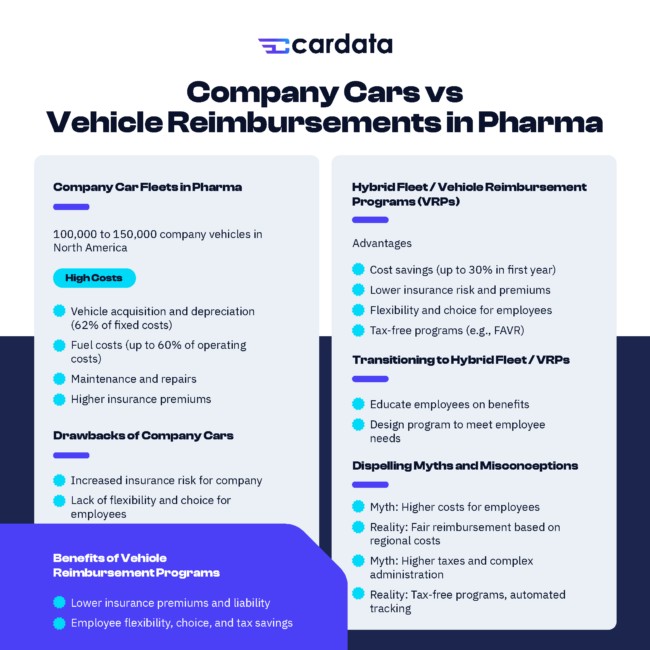Pharmaceutical sales representatives are the linchpin of revenue generation in the pharmaceutical industry. Their ability to build relationships and facilitate purchases with healthcare distributors is crucial. In fact, a study in Pharmaceutical Commerce indicated that up to 94% of pharmaceutical purchases industry-wide are influenced by distributor sales reps. For pharmaceutical sales managers, optimizing every aspect of their team’s operations is paramount, and this includes a critical, often overlooked area: vehicle programs.
Historically, pharmaceutical companies have maintained substantial company car fleets. AstraZeneca, for example, manages a fleet of 16,000 vehicles. Across North America, estimates suggest that pharmaceutical company cars account for a significant portion of the 300,000 company-owned vehicles on the road. While company cars were once seen as a prestigious perk and a practical solution, especially for industries dealing with sensitive products, the landscape is shifting. In today’s fiercely competitive pharmaceutical market, every expenditure is scrutinized, and resources are better directed towards research, development, and strategic marketing initiatives. This article explores why transitioning from traditional company car fleets to personally-owned vehicle programs, particularly Fixed and Variable Rate (FAVR) reimbursement programs, can lead to significant cost savings and improved employee satisfaction.
 Pharmaceutical sales team and fleet reimbursement
Pharmaceutical sales team and fleet reimbursement
Understanding the Vehicle Needs of Pharmaceutical Sales Reps
Pharmaceutical sales roles often demand extensive travel. Representatives are frequently on the road, visiting healthcare providers, hospitals, and pharmacies across territories that can range from dense urban centers to sprawling rural areas. The “kind” of car that best suits these professionals isn’t just about prestige or comfort; it’s about practicality, reliability, and efficiency. Considerations include:
- Mileage: Pharmaceutical sales reps typically log high mileage annually. Vehicles must be durable and fuel-efficient to withstand constant use and minimize fuel expenses.
- Territory: Driving conditions vary dramatically. A rep covering a rural territory with challenging weather conditions might require a different vehicle type than someone primarily operating in a city.
- Professional Image: While practicality is key, the vehicle also contributes to the sales rep’s professional image. It should be presentable and reflect the company’s standing.
- Personal Preference: Recognizing that a car is a personal choice, programs that offer flexibility can boost employee morale and satisfaction.
The Hidden Costs of Company Car Fleets
While the initial appeal of company car fleets lies in centralized management and perceived control, a closer look reveals substantial direct and indirect costs.
Vehicle Acquisition and Depreciation
Purchasing vehicles in bulk offers some economies of scale, yet depreciation remains a significant financial drain. As soon as a new car leaves the dealership, it begins to lose value. Industry experts point to depreciation as accounting for a large portion of fleet management fixed costs, potentially as high as 62%.
Fuel Expenses
Fuel is another major variable cost, often constituting up to 60% of total fleet operating expenses in the pharmaceutical sales sector. Fluctuations in fuel prices and regional differences can translate to considerable budget variances across a large fleet.
Maintenance and Repair
Routine maintenance and unexpected repairs are inevitable with high-mileage vehicles. Fleet management must account for vehicle downtime, scheduling maintenance, and managing repair costs, all of which add to operational overhead.
Insurance Premiums
Insuring a fleet of vehicles typically attracts higher premiums compared to individual car insurance policies. Insurance companies recognize the increased risk associated with institutional ownership and the potential for higher claim volumes.
Drawbacks of Company Cars in the Pharmaceutical Industry Context
Beyond the direct financial costs, company car fleets present several operational and employee-related drawbacks, particularly within the pharmaceutical sector.
Increased Insurance Liability
Organizations with company car fleets assume considerable liability. They are responsible for accidents, regardless of whether they occur during work hours. Even if an employee is at fault in an off-duty incident, the company, as the vehicle owner, can be held liable. This broad liability exposure can lead to significant financial risks.
Limited Employee Flexibility and Choice
Company car programs often restrict employee choice. The vehicle assigned might not align with an individual’s personal needs or preferences. For sales professionals who value autonomy and personalization, this lack of flexibility can be a demotivator. Furthermore, in an era of increasing environmental consciousness, employees might prefer to drive more fuel-efficient or electric vehicles, options not always available within a standardized company fleet. Offering vehicle choice, including environmentally friendly options, can be a significant advantage in attracting and retaining top talent. If competitors offer vehicle allowances or reimbursement programs, companies relying solely on company cars may find themselves at a disadvantage in the talent market.
The Advantages of Vehicle Reimbursement Programs
Shifting to a well-structured vehicle reimbursement program offers compelling advantages for pharmaceutical companies.
Significant Cost Savings
The most immediate benefit is cost reduction. By transitioning from fleet ownership to reimbursement, companies can reduce fixed costs by as much as 30% in the first year alone. As programs are refined and data insights are applied, further savings can be realized. Reimbursement programs convert fixed fleet costs into variable costs, aligning vehicle expenses more closely with actual business needs.
Reduced Insurance Risk and Premiums
Vehicle reimbursement programs shift the primary insurance liability to the employee’s personal auto policy for non-business use. The company’s responsibility is then limited to incidents occurring during business activities. This significantly reduces the organization’s overall insurance risk and can lead to lower premiums. Moreover, individual insurance premiums often reflect safe driving records, rewarding responsible employees and indirectly benefiting the company.
Enhanced Employee Satisfaction and Flexibility
Programs like FAVR empower employees with vehicle choice. They can select vehicles that suit their personal needs, preferences, and driving conditions, as long as they meet reasonable company guidelines. This sense of ownership and control boosts morale and job satisfaction. Furthermore, tax-advantaged programs like FAVR can increase employees’ take-home pay by providing reimbursements that are not taxed as income, further enhancing their financial well-being.
Transitioning to a Vehicle Reimbursement Program
Change management is crucial when moving from company cars to a reimbursement model. Employees need clear communication and education to understand the benefits and address any concerns.
Designing a Program that Meets Employee Needs
The flexibility inherent in IRS guidelines allows for tailoring vehicle reimbursement programs to meet specific employee needs and regional cost variations. Engaging employees in the design phase, soliciting feedback, and addressing their concerns proactively ensures a smoother transition and greater program acceptance.
Dispelling Common Myths about Vehicle Reimbursement Programs
Misconceptions can hinder the adoption of vehicle reimbursement programs. Addressing these myths head-on is essential.
Myth: Higher Costs for Employees
Reality: Well-designed programs like FAVR are structured to reimburse employees fairly, accounting for regional cost differences in fuel, maintenance, and vehicle depreciation. They eliminate the inequities of uniform payments that disadvantage employees in high-cost areas.
Myth: Higher Taxes and End-of-Year Burdens
Reality: Reimbursements under programs like FAVR are tax-free, reducing employees’ income tax liability. This is a significant financial advantage compared to taxable car allowances or company car benefits that can be considered taxable income.
Myth: Administrative Complexity
Reality: Modern solutions like Cardata Mobile automate mileage tracking, expense reporting, and reimbursement processing. These tools streamline administration, reduce paperwork, and ensure accurate and timely reimbursements, often simplifying processes for both employees and administrators compared to traditional fleet management.
Conclusion
While company car fleets may seem traditional in some industries, for pharmaceutical companies focused on optimizing resources and empowering their sales teams, vehicle reimbursement programs offer a superior alternative. By transitioning to a program like FAVR, pharmaceutical organizations can:
- Reduce Costs: Achieve significant savings on vehicle acquisition, operation, and administration.
- Minimize Risk: Lower insurance liability and premiums.
- Boost Employee Satisfaction: Offer greater vehicle choice, flexibility, and financial benefits.
In a dynamic and competitive pharmaceutical landscape, strategic decisions that enhance efficiency and employee well-being are paramount. Switching from a company car fleet to a structured vehicle reimbursement program is a financially sound and employee-centric move that positions pharmaceutical companies for continued success.
To explore the potential benefits of transitioning to a vehicle reimbursement program for your pharmaceutical sales team, schedule a consultation with a Cardata expert today.
Disclaimer: Cardata strives to provide accurate and reliable content. However, this article is for informational purposes only and not financial or legal advice. Consult with qualified professionals for specific guidance.
References
[1] Patient Centricity in the Pharma Supply Chain
[2] Ibid.
[3] Why Temperature Controlled Shipping is Vital to the Medical Field
[4] Managing pharma auto fleets
[5] Pharma sales reps’ company cars might be going electric sooner

